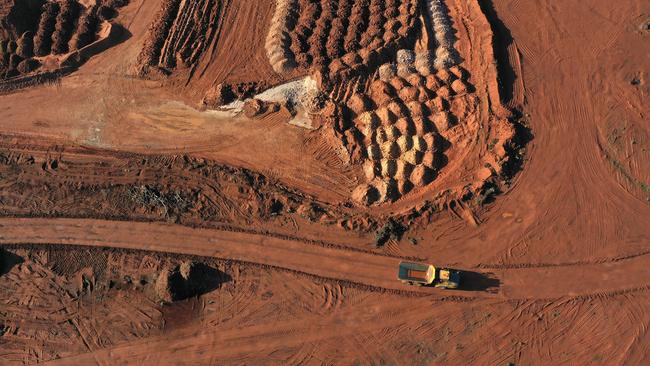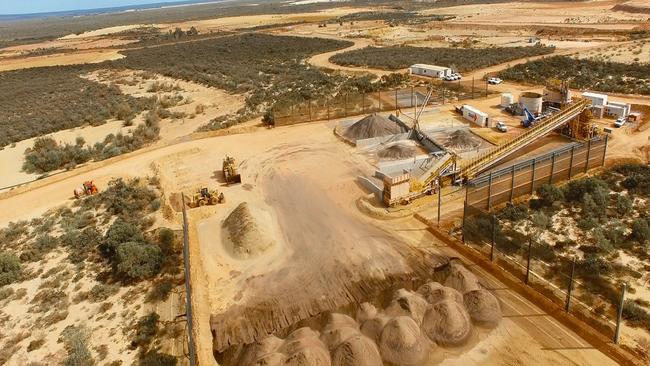
While Australia is in the box seat in terms of having access to supplies of critical minerals — which include rare earths, lithium, copper, nickel, magnesium, and zinc — the question is how best position the country to take advantage of its role.
The issue will be a key point of discussion at the Critical Minerals Summit being hosted by the Australian on Friday with the support of consulting firm PwC.
Rare earths and other critical minerals play a key role in the electric vehicle supply chain as well as the magnets needed for wind turbines.
Fortescue Metals executive chairman Andrew Forrest signalled this week that his company, which has made its fortune selling iron ore to China, was stepping up its interest in becoming involved in the sector.
Forrest sees rare earths as “critical” for its ambitious green hydrogen energy strategy, describing them as a “rapidly growing market (which is) set to bring added value for our shareholders.”
Australian companies involved in the rare earth business include Lynas — which currently processes its rare earths mined in Australia in a plant in Malaysia, and is building a processing plant in Kalgoorlie — and Iluka Resources, which is also developing its refinery, estimated to be worth more than $1bn, in Western Australia.

While politicians have recently elevated critical minerals to a high security stage, companies involved in the sector in the past have not found it easy, in the past, to raise finance.
Lynas has had to rely on strong support from Japanese investors wanting to secure access to its output, and is now being courted in the US, a country which saw some of its domestic players collapse years ago due to the economics of processing in a developing country, handing over the market to Chinese companies.
Environmental issues with some critical mineral processing have also affected the economic viability of projects.
But things are changing as geopolitical tensions increase, with rising concerns over China’s domination of the supply of some key rare earths rising, while demand for the whole gamut of critical minerals increases for their role in the new green economy.
US President Joe Biden has moved to rectify the situation with his Inflation Reduction Act, which is aimed at encouraging the development of the clean energy sector in the US and focuses on having US companies work with friendly countries for their supplies to the sector.
Discussing the outlook for the renewable energy sector this week, David Scaysbrook, managing director of Quinbrook Infrastructure Partners, a $3bn clean energy fund, predicted that Biden’s Inflation Reduction Act (IRA) would have “big impacts here and for the supply chain.”
“It has very far-reaching implications, not only for the United States, but also for the alliance between Australia and the United States in particular,” he said.
The legislation contains assistance worth more than $US50bn in US domestic manufacturing, from battery components to battery storage to solar module manufacturing.
“That is creating significant new industrial demand for rare earths, critical minerals, raw material, most of which and a lot of which we have here in Australia,” he said.
“This means a lot for WA and Queensland and will create investment in areas of Gladstone and Townsville and far north Queensland that will open up these areas.”
Critical minerals, he said, represented “a material new export opportunity” for Australia.
“We need to think more (than) just repeating the quarry mentality of shipping raw materials to America, versus onshore value add processing wherever it might be,” he said.
“We need to start to see really tangible examples of commitments being made to new processing here in Australia.”
In an interview with The Australian this week, ahead of the summit, PwC Australia CEO Tom Seymour urged governments to modernise mining regulations to help encourage the development of critical minerals in Australia.
“Whether it’s renewable panels or wind turbines – right through to all the elements that drive electrification, you need an enormous increase in the critical minerals being supplied to the world,” he said.
“You can go through every critical minerals category and its exponential, the increase the world needs,” he said.
While China is rich in critical minerals, he said there were opportunities for Australia as companies, particularly those from the US, Japan and South Korea, looked to alternative sources of supply.
But he said there was a need for urgent government action in Australia to turn a potential opportunity into a reality.
He urged the federal government to set up a task force to accelerate the approval of new mines and to modernise mining regulations.
Foreign policy has the potential to play an important role.
Seymour called on the federal government to work closely with countries like Japan and South Korea to encourage the development of the sector in Australia.
Another issue is China’s investment in the sector in Australia.
Chinese owned Tianqi Lithium has a joint venture in WA based Greenbushes, the world’s largest hard rock lithium mine, while Chinese owned Ganfeng Lithium has stakes in two smaller lithium mines in Australia.
Some commentators have suggested that the breaking of the ice between Australia and China with the meeting of Chinese president Xi and Prime Minister Albanese in Bali last week may have been driven by Chinese interests in continuing resource supplies from Australia – from iron ore to critical minerals.
In a paper produced by Dr Corey Lee Bell, Elena Collinson and Professor Xunpeng Shi at the Australia China Relations Institute at Sydney’s UTS in The Diplomat magazine earlier this month, argues that lithium could provide a key avenue for mending the Australia-China Relationship.
A recent conference in Canberra hosted by the Australia China Business Council, Tianqi Lithium Australia chief executive, Yasmin Liu, outlined the potential to be gained from closer ties between the lithium industry in Australia and buyers such as the electric car industry in China.
In his talk to the Sydney Institute last week, Federal Trade Minister Don Farrell also identified critical minerals as having key export potential for Australia.
While critical minerals has become a topic du jour in strategic sectors, the next step is to drill down into the specific issues needed to maximise its potential for Australia.
Friday’s summit will provide the opportunity to do just that.




The combination of increased geopolitical security concerns with the global push for decarbonisation has put the issue of critical minerals under the spotlight.